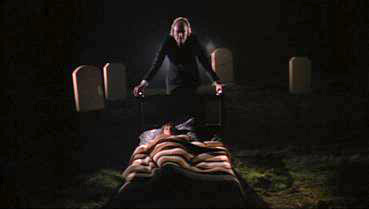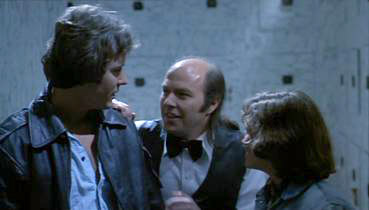|
As
a genre, horror has had its moments in the mainstream sun
and stretched beyond the realms of cult cinema. But there
are still films that serve almost as a membership test to
true genre fandom, films that horror fans adore
but that a mainstream audience just wouldn't know what to
do with. Phantasm is most definitely one
of them. On its initial release, the somewhat austere
Films and Filming magazine really laid into it,
the reviewer in question having only just recovered from
David Lynch's Eraserhead (I loved that,
too). As a review intended to dissuade readers from seeing
the film, it may well have worked for the Merchant-Ivory crowd,
but for a hardcore horror fan, every point made against
it worked more as a taster for what was sounding increasingly
like a genre treat.
Oh
yes.
The
American independent horror film was never more vibrant
than in the 1970s, where it was often used as a calling card for new directors able
to fund projects on the promise of sensationalism and drive-in distribution. Denied the budgets
of their big-budget contemporaries, the filmmakers got
inventive with their storylines and film technique,
and horror fans responded accordingly, turning a blind eye
to dodgy effects and iffy make-up to relish in the
storytelling, the characters, the atmosphere and the violence. And, in certain
special cases, the strangeness.

Plot
summaries of Phantasm, if they are to avoid
giving away later twists, inevitably suggest a narrative
that dances through peculiarity for the sake of it. This is not always a bad thing, of course, but does tend to hand ammunition
to the anti-horror crowd, and in this case such an assumption would really be misplaced.
If you're new to the film, and you have to be either new
to 1970s horror or very, very young to be so, then try this
on for size.
20-something
Jody and his young brother Mike live alone after the death
of their parents two years previously. When Jody's pal Tommy
is murdered, Jody and
his closest friend Reggie attend his funeral at the nearby
Morningside Cemetery. Mike, who fears that Jody may be planning
to move away and abandon him, follows him there and is spooked
by strange noises and figures darting between the gravestones.
He watches the funeral ceremony from a distance, but afterwards
observes a tall and imposing funeral worker pick up Tommy's
coffin and place it in the hearst as if it were made of
paper. Twice more he is threatened by the mysterious small creatures,
and when Jody dismisses his claims he breaks into the funeral
home and narrowly avoids being killed by a flying silver
sphere, which instead attacks a caretaker, drilling
a hole in his head and rapidly draining him of blood. A short while later Mike is spotted and chased by the tall funeral worker, whose
fingers become trapped when Mike slams a door on his hand. Mike cuts them off with a knife,
but they continue to move independently after they hit the floor. He takes one with him to show it to Jody,
but it transforms into a vicious flying bug that attacks
them when released. Shall I go on?
The film certainly trades on its strangeness in the early stages,
embracing it from the start to create a genuinely unsettling
atmosphere of other-worldly menace. The funeral home interior is a good example, its white marbled corridors
and distant electronic hum making it as creepy as the darkest
of gothic castles, one host to its very own flying mechanical
vampire, as iconic a creation as anything in modern horror
cinema. Actually, Phantasm manages that
rare trick of also creating a second horror icon in the shape of The Tall Man, a role that made actor Angus Scrimm
a favourite with fans. It is he that provides one of the most memorably peculiar
moments, as the film speed slows to emphasise
his long-legged stride and the natural sound receeds until only
the clomp of his footsteps can be heard. Then, unexpectedly,
he stops, turning as if he has sensed something, only to
react either with pain or orgasmic pleasure (you decide)
at the cold air emanating from Reggie's ice-cream truck.
Oh
wait a minute, there's horror icon number three: Reggie
Banister. It's hard to pin down exactly what has made Reggie
so popular with the film's fans, but we love him nonetheless.
Reggie's the sort of reluctant hero those of us who've left
their twenties behind want in our horror films. Balding,
pony-tailed and only a tad past his prime, he's a musician
at heart who pays his way in a workaday job and is just
not ready for what happens to him and his friends. Reggie survives on his luck, his wits and his unforced, post-hippy cool.
For us, Reggie's the man.

And
so back to the plot. Did I mention the hooded dwarfs, who
aren't dwarfs at all but regular people crushed down to
half their size? That they look like the sand people in
Star Wars is unfortunate but coincidental
– Coscarelli got started on Phantasm (at
the tender age of 23) before even the trailers for Lucas's
film first hit the streets. But they fit in here perfectly. Surrealistic
strangeness runs throughout Phantasm's
entire, joyous length, but its unexpected trump card
is that as we approach the end, much of we previously saw as peculiarity
starts to make sense.
The film scores repeatedly
on originality of ideas and obvious antecedents are not easy to spot, though there are a couple of unexpected influences,
with the design of a key set inspired by Kubrick's 2001 and Mike's hand-in-a-box trial borrowed from Frank
Herbert's Dune, a scene that was to reappear later
in David Lynch's film adaptation.
If
some of the special effects seem a little ropey (the finger
bug is a comically cheap creation), others work well.
The flying sphere in particular poses as a most convincing and dangerous
threat, having the speed and precision of a bloodthirsty cruise missile and delivering its bloody coup-de-grace with a horribly whirring drill.
The performances are also on variable side. Bill Thornbury
sometimes feels a tad wooden as Jody and Angus Scrimm hams it up, but this is rather well balanced by some convincing work by young Michael Baldwin as Mike and Reggie Bannister's effortless cool.
But
in the end it's Coscarelli's show. As writer, director,
cameraman and editor, he is very much the auteur here and
deserves the praise for creating such an atmospheric, inventive
and enjoyable cult favourite that has stood the
test of time very nicely. It's almost a shame that the film's success
saw him spend so much
of the next twenty years pumping out sequels instead of
moving on to pastures new, but he has since made good on
this initial promise with the hugely enjoyable Bubba
Ho-Tep. That he is set to make a follow-up
to that movie hints that Coscarelli's own history may be
about to repeat itself.
If
the extra features have been recycled from elsewhere (see
below), then it's the image and sound quality that provide the
principal reason for upgrading to this new edition. The
picture on the old MGM region 1 release was sound enough
but non-anamorphic, and Anchor Bay have not just delivered
an anamorphic transfer, but an damned good one – this is
certainly the best I have ever seen Phantasm
look on DVD, with sharpness, colour and especially contrast
very impressive. Black levels are superb, and given the
number of scenes set at night, this is crucial. There is still some
dust and minor print damage on show, but it does not distract.
Upgrade
number 2 involves the soundtrack. There are three on offer,
the original mono 2.0, a 5.1 remix and DTS, which is essentially
the 5.1 with a tad more wallop. It's good to have the original
track, but the remix really adds to the atmosphere, spreading
the sound out and adding clarity and range. The real ear-opener
is the White Room, which always had some serious bass but
on the DTS remix threw so much deep vibration around my
living room I thought my ears were going to bleed.
It
should be noted that this is at least the third outing for
the extra features included here. Created first for the
film's original laserdisc release, they were recycled for
MGM's region 1 disc a few years back and have turned up
again unmolested here. If you already have any of the previous
incarnations, as I have, this is a tad disappointing, but
on the up side they are rather good and if you don't have
them already you'll be happy enough.
A
Commentary from director Coscarelli
and actors Michael Baldwin, Bill Thornbury and Angus Scrimm
provides a nice mixture of insight and personal reminiscences.
Sound quality is slightly below par, with a noticeable hiss
hovering in the background, except on most of Angus Scrimm's
contributions, which, although directly responded to by
the others, almost sound re-recorded. Maybe he was sitting the closest to the mic.
The
Introduction by Angus Scrimm
(2:17) directly preceded the film on the previous DVD release,
but I do prefer it as a separate extra (when I start a film
I want to get straight to it). It's a 4:3 video address
to camera, rather basically lit and has a little touch of
Criswell about it, but will amuse the fans nonetheless.
The
Deleted Scenes (9:59) are presented
as a mixture of non-anamorphic 1.85:1 and 4:3, with either
unmixed and non-existent sound. A combination of slightly
wobbly character scenes and more intriguing plot-driven
sequences, they include an alternate climax involving an
exploding Tall Man, and the excellent line, "You think
you go to heaven? You go to US!" which was recycled
to slightly less effect in Phantasm II.
The
Original Theatrical Trailer (2:10)
is non-anamorphic 1.85:1 and in OK if not sparkling shape
(especially the audio). It includes a little too much of
the later scenes for newcomers.
Behind
the Scenes Footage (19:59) is 4:3 super-8
footage of the shoot, with a commentary by Coscarelli and,
making up for his absence on the main commentary somewhat,
Reggie Bannister (rah!). The transfer to video, or perhaps
from NTSC, has caused some minor wobbles in places, but
the footage itself is super-8 and thus hardly in pristine
condition anyway. It matters not, this is invaluable stuff
for fans of the film, showing how scenes were filmed and
including a few nice off-the-cuff moments (Angus Scrimm
standing motionless under an umbrella waiting for his cue
I particularly liked).
Finally
there are Biographies for Coscarelli,
Reggie Bannister, Bill Thornbury, Angus Scrimm, Michael
Baldwin and Fred Myrow.
OK,
the extras are recycled, but the picture and sound are very
good, and this alone may prove worth the buy for the film's
fans. Of course, if you're a real devotee you'll go for
the 5-disc sphere box set,
which has the coolest packaging I've seen, well, ever, and
includes a bonus disc that will be reviewed separately, as will the other three
films in the series. If you're new to the film then whether
it starts your motor will depend on your credentials as
a horror fan, but for those us with 'hardcore' stamped on
our membership cards, this is what low budget independent
horror is all about. All together now… "BOOOOOOYYYY!!!!"
|